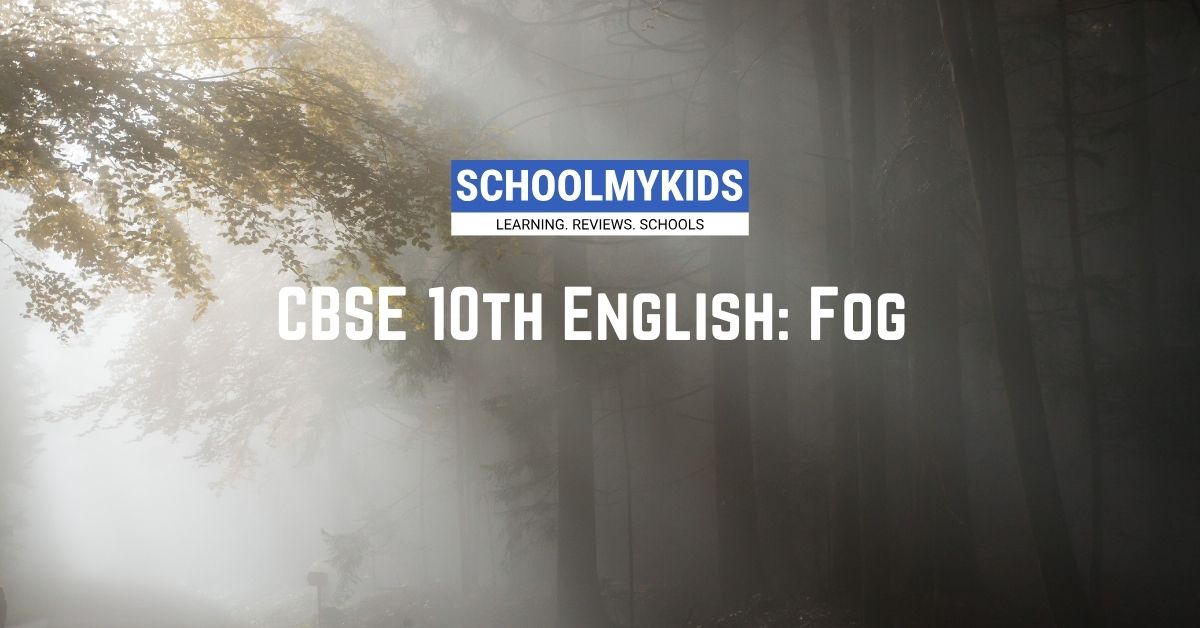“Fog” is a poem from the Class 10 CBSE English textbook, “First Flight.”
Summary
“Fog” by Carl Sandburg is a succinct yet evocative poem included in the CBSE 10th board English syllabus. It exemplifies Imagist poetry, a literary movement focused on clarity, precision, and economy of language. In “Fog,” Sandburg uses the metaphor of a cat to depict the movement and nature of fog, creating a vivid image with minimal words.
The poem begins with the observation that the fog “comes on little cat feet.” This comparison instantly evokes the quiet, stealthy approach of a cat, mirroring how fog often appears silently and unexpectedly. The fog is then described as sitting “looking over harbor and city on silent haunches,” suggesting both a physical presence and a sense of watchful calm. Finally, the fog “moves on,” much like a cat that sits for a while before silently slipping away.
Analysis
“Fog” is a masterful example of how powerful imagery and metaphor can convey deep meaning in just a few lines. Sandburg’s choice of a cat as a metaphor for fog is particularly effective because it captures the essence of fog’s silent, mysterious, and transient nature. The cat’s feet, haunches, and movement all parallel the characteristics of fog, making this comparison both apt and evocative.
The poem’s structure is simple and concise, with no unnecessary words. This brevity is a hallmark of Imagist poetry, which aims to capture a moment or an image with clarity and precision. Sandburg’s use of free verse also contributes to the poem’s fluid, natural feel, mirroring the effortless way fog moves and transforms the landscape.
Important Questions with Explanations
- What is the central theme of Carl Sandburg’s “Fog”?
- The central theme of “Fog” is the transient and mysterious nature of fog, captured through the metaphor of a cat. This theme reflects how natural phenomena can have both a physical and an almost ethereal presence.
- How does Carl Sandburg use metaphor in the poem “Fog”?
- Sandburg uses the metaphor of a cat to describe the fog. This comparison effectively captures the fog’s silent, stealthy, and transient nature, making the abstract concept of fog more tangible and relatable.
- Describe the imagery used in “Fog” and its significance.
- The imagery of a cat’s silent feet, haunches, and movement creates a vivid picture of how fog approaches, settles, and departs. This imagery highlights the fog’s quiet presence and fleeting nature.
- What does the fog symbolize in the poem?
- The fog symbolizes mystery, transience, and the quiet, often unnoticed forces of nature. It also represents the delicate and ephemeral aspects of life.
- Explain the significance of the line “comes on little cat feet.”
- This line emphasizes the silent and stealthy arrival of the fog, akin to how a cat moves quietly and unnoticed. It sets the tone for the entire poem, highlighting the fog’s subtlety.
- What does the phrase “on silent haunches” convey about the fog?
- The phrase suggests the fog’s calm, watchful presence. It sits quietly, observing the world, much like a cat does. This imagery reinforces the fog’s silent and unobtrusive nature.
- How does Sandburg’s use of free verse enhance the poem?
- Free verse allows Sandburg to create a fluid and natural rhythm, mirroring the effortless and organic movement of the fog. It also emphasizes the simplicity and precision of the imagery.
- What mood does the poem “Fog” evoke?
- The poem evokes a mood of calmness and contemplation. The fog’s quiet and mysterious presence creates a sense of peace and introspection.
- Discuss the effectiveness of the poem’s brevity.
- The poem’s brevity is highly effective as it captures a fleeting moment with clarity and precision. Each word is carefully chosen to convey the essence of the fog, making the imagery more powerful.
- How does “Fog” reflect the principles of Imagist poetry?
- “Fog” reflects Imagist principles through its clear, precise imagery, and economy of language. It focuses on a single, vivid image and conveys a moment of perception without unnecessary words.
- What can readers infer about Sandburg’s view of nature from “Fog”?
- Readers can infer that Sandburg views nature as subtle, mysterious, and powerful in its quiet presence. He appreciates the delicate and transient aspects of natural phenomena.
- Analyze the significance of the poem’s setting.
- The setting, described as a harbor and city, contrasts the natural fog with the man-made environment. This juxtaposition highlights the fog’s ability to transform and soften the urban landscape.
- How does the poem’s imagery create a visual effect?
- The imagery of the cat creates a visual effect by allowing readers to picture the fog moving stealthily and settling quietly. This visualization enhances the sensory experience of the poem.
- What is the impact of the poem’s concluding line, “and then moves on”?
- The concluding line emphasizes the transient nature of the fog. It reinforces the idea that the fog, like a cat, comes and goes silently, leaving a fleeting impression.
- How does the metaphor of the cat deepen the reader’s understanding of fog?
- The cat metaphor deepens understanding by associating fog with qualities like stealth, quietness, and mystery. It makes the abstract concept of fog more relatable and vivid.
- What literary devices are used in “Fog” besides metaphor?
- Besides metaphor, Sandburg uses personification, ascribing animal characteristics to the fog, and imagery, creating vivid mental pictures with minimal words.
- How does the poem “Fog” align with the themes of modernist poetry?
- “Fog” aligns with modernist themes by focusing on a simple, everyday moment and capturing it with clarity and precision. Its brevity and focus on imagery reflect modernist sensibilities.
- Discuss the use of silence as a theme in the poem.
- Silence is a central theme, emphasized by the fog’s quiet approach and presence. The poem’s language and imagery reflect this silence, creating a peaceful and contemplative mood.
- What emotions does “Fog” evoke in the reader?
- The poem evokes emotions of calmness, curiosity, and a sense of wonder. It encourages readers to pause and appreciate the quiet beauty of natural phenomena.
- How does “Fog” inspire readers to observe their surroundings more closely?
- By highlighting the subtle and often overlooked presence of fog, the poem inspires readers to pay attention to the quiet, transient moments in their surroundings, fostering a deeper appreciation for nature.
Conclusion
Carl Sandburg’s “Fog” is a profound example of Imagist poetry, capturing the essence of fog through the simple yet powerful metaphor of a cat. Its brevity and precision make it an effective and memorable piece, inviting readers to contemplate the quiet and transient beauty of natural phenomena. For students preparing for the CBSE 10th board English exam, understanding “Fog” provides insights into the use of imagery, metaphor, and the principles of Imagist poetry, enriching their literary analysis skills.








Be the first one to comment on this story.